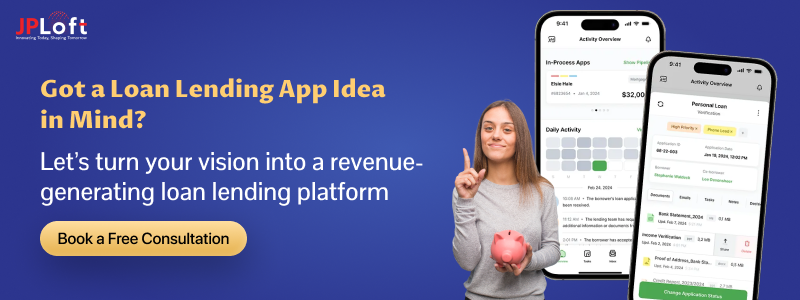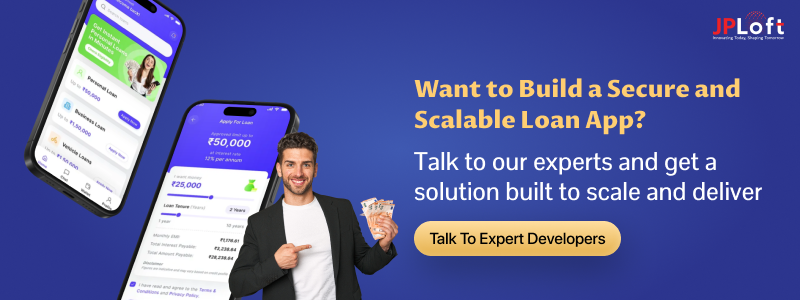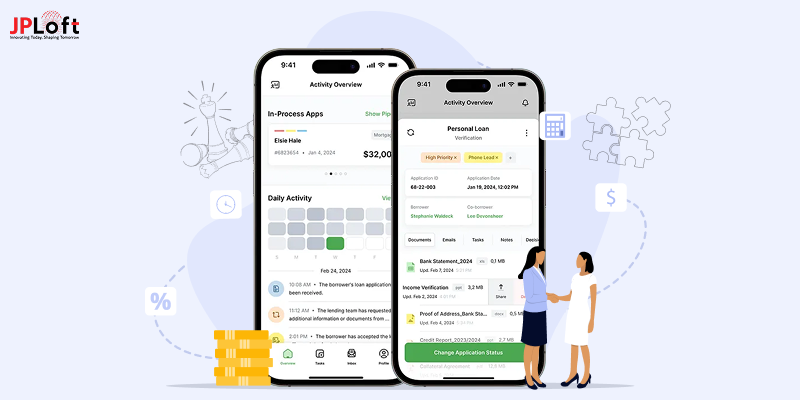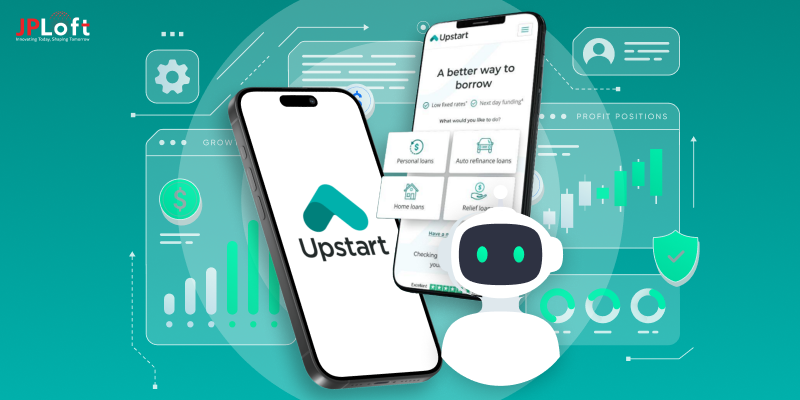Ever wondered how free loan apps generate revenue? Despite offering zero upfront charges, these platforms have a valuation in millions. Let’s break down how.
Loan Lending is one of the core business segments focused on in the financial sector.
From banks to independent institutions and beyond, every player in the sector has a business segment that aims to generate revenue through lending.
The global lending market is expected to grow at a CAGR of 7.06% reaching $21 trillion by 2023.
A key innovation in such a business model is the introduction of loan lending apps, which have significantly transformed the way people borrow money.
While most of these apps are free for users and have almost zero upfront charges, the real question is: “How do loan lending apps make money?”
Don’t be surprised to know that most loan lending apps operate on smart and scalable monetization strategies that help balance both the revenue and user experience.
Some commonly preferred approaches of loan lending apps to make money include revenue from interest, processing fees, late penalties, and commission. Apart from these, several other loan lending app monetization approaches are being focused on by modern-day loan lending apps.
In this blog, we will discuss in detail the money lending app monetization strategies and explore why they are rapidly becoming a profitable arm of the fintech ecosystem.
Key Takeaways:
The primary way loan lending apps make money is through interest rates, processing fees, late payment penalties, and commission from cross-selling financial products.
Cross-selling and subscription-based models help boost revenue, improve user engagement, and increase customer lifetime value.
Data monetization and in-app advertising can act as secondary income streams for loan lending apps when implemented ethically and with user consent.
AI and machine learning can enhance the potential of a loan lending app through predictive credit scoring, dynamic interest modeling, and automated loan processing.
Studying successful apps like Upstart, SoFi, and LendingClub offers insights into how leading players optimize their platforms for profitability.
Partnering with experienced loan app developers at JPLoft ensures your monetization strategies are built into the product from day one.
What Is a Loan Lending App?
Before we proceed to discussing the loan lending app monetization strategy, let’s have a brief overview of what a loan lending app is.
These apps can be defined as a digital platform that allows users to apply for and receive loans digitally, without the need to visit a bank physically. They have streamlined the borrowing process, offering instant loans based on automated credit checks and digital documentation.
The common types of loans or credit offered through these platforms include personal loans, payday loans, small business loans, and even P2P loans.
With the increasing focus on digital lending, these apps are surely redefining how credit is being distributed across urban and rural economies. Hence, the success of these loan lending app business models is supported by the transforming expectations of users for convenience, speed, and trust in the lending process.
If you are planning to introduce your loan lending app, then you can partner with the best mobile app development company, discuss your vision, and execute the project in real time.
Why is Understanding Loan Lending App Monetization Strategies Important?
You might be wondering why there is a need to focus on how these apps monetize their platform. It can be figured out once you enter the market and interact with customers.
However, it’s not the right approach to follow. When you are planning to create a money lending app as your next venture, you need to be aware of how you will monetize it.
So let’s focus on some common monetization strategies followed by loan lending apps.
1. Plan Operational Cost and Revenue Model
Focusing on money lending app monetization models helps you better understand how you are going to generate revenue for your new venture.
Such a focus can include evaluating competitors’ revenue models and other industry-ready approaches that can be leveraged to cover the operational cost, as well as the loan lending app development cost.
2. Supports Long-Term Growth and Scalability
Understanding how a loan lending app makes money is important so that you can integrate them into your business model and leverage them to make money.
Also, a well-defined monetization strategy is significant to ensure that the app keeps running, and the revenue can be leveraged to make necessary updates and improvements over time.
3. Understand Transforming Trends
Focusing on the monetization approach also helps you understand the loan lending app trends.
Such trends include understanding how these apps are delivering user value, attracting customers, driving engagement, and retaining their strategic positioning.
Based on such trend analysis, you can also understand the key challenges of developing money lending apps aligned with the trends and can plan accordingly.
4. Data-Driven Insights
Understanding the existing loan lending app monetization models can help businesses get data-driven insights on how these monetization strategies are performing.
You can know about the user behavior for these monetization strategies, their preferences, as well as how these strategies are helping enhance the overall performance.
How Do Loan Lending Apps Make Money?
Being an entrepreneur, you can also plan to enter such a transforming industry with a unique and engaging loan lending business model.
But will your model scale? It depends mainly on the loan lending app monetization approaches being adopted by you.
So, let’s proceed to discuss some common money lending app monetization strategies that you can’t afford to skip in your business model.
Here’s a detailed breakdown;
► Revenue From Interest
The primary way a loan lending app makes money is through the interest charged on the borrowed amounts.
Such interest rates can be fixed or dynamic depending on the user’s profile, their creditworthiness, and risk profile. Not only the user’s profile, but also the interest rates can vary based on the loan amount and repayment terms.
Hence, when planning or defining your loan lending app business model, you need to define your interest strategy. A loan lending app with affordable interest rates can encourage users to borrow from your app, but it can put your business model at risk.
Also, the interest rates on your platform can vary based on the credit product offered, which can be payday loans, personal loans, business loans, or any other specific loan category offered on your platform.
► Transaction Fees
In addition to the interest, the loan lending apps also charge a one-time processing fee or a transaction fee at the time of loan disbursal.
Such fees commonly range from 1-5% depending on the borrower’s risk profile, selected loan product, loan amount, and other associated factors. It can either be deducted upfront or added to EMI.
These charges are collected to cover the processing and underwriting of a loan application, and conducting relevant verifications and documentation.
The loan lending apps also charge a small commission as a transaction fee, even during the repayment or prepayment of the loan.
► In-App Advertising
It is also a considerable approach to generate revenue or monetize a loan lending app.
But it is only effective if your app has a robust user base, a vast audience portfolio, and has been designed to handle such third-party advertisements.
However, while integrating such a strategy in your loan lending app, you need to ensure that the advertisements shown are relevant and do not promote your competitors.
You can consider partnering with brands in the industry, and accordingly, can consider showcasing their advertisements on your app. In exchange, they can help you improve your brand visibility.
It is recommended to hire dedicated developers to ensure that your app can handle such in-app advertising needs and ensure your mobile app security when allowing such third-party integrations.
► Cross-Selling Financial Products
Another revenue model to consider is cross-selling financial products.
Such cross-selling can be of the financial products offered by you to your users, or can be from your partnered brands.
The commonly offered financial products include credit cards, investment plans, loan protection insurance, and even savings accounts from your partnered banks.
These cross-product offerings are not just important from the point of revenue generation, but also help expand the product offerings on your app and boost engagement.
For each additional financial product sold, you can either earn the profit (if the product is from your portfolio) or a commission (if it's from your partnered brand).
► Subscription Models
While planning the business models of loan lending apps, you can also check out the relevant subscription options to keep your targeted audience hooked with your platform.
Such a subscription approach can include offering paid and premium plans to users, with additional loan lending app features like best loan recommendations, faster approval, extended repayment periods, and any other relevant benefits.
These approaches can act as a great opportunity to offer a continued flow of revenue with each subscription renewal.
Also, such helps the platform to evaluate and understand how actively and positively the audiences are engaging with the platform and what relevant improvements need to be introduced.
► Data Monetization
An effective way to monetize a loan lending app is through data monetization. The loan lending apps generate high-quality consumer data, which can be used by third-party platforms for decision-making.
Hence, the loan lending apps lend out this data in exchange for economic benefit, which can act as a key revenue stream for the app.
However, while opting for such a strategy, it is important to fulfil the ethical and responsible practices. Such includes obtaining users' consent, as well as ensuring that the data is being used responsibly.
► Freemium Model
It is one of the most effective methods to consider in your early days of app launch. Such a feature involves offering a set of features on your loan lending app for free to the users.
A freemium model helps you attract the attention of the targeted audience and retain them for long intervals. Also, the loan lending apps can plan to offer basic services for a fixed time duration under this freemium model.
A key benefit of such a strategy is that it allows new users with a potential time frame to test new features, understand the platform, and invest accordingly.
► Late Payment Penalties
It doesn’t comprise a major chunk of the loan lending app monetization strategy, but it can’t be ignored.
When a borrower borrows from your app, there is a chance that they might default or delay in payments. Hence, in such scenarios, the loan lending apps charge a small fee or impose late payment penalties, which can either be a flat fee or a percentage-based fee.
Such late fees are often charged after a grace period, and it is a non-compliance revenue that helps cover risks and offset losses from defaults.
► Commissions
If your loan lending app has a vast audience base, then you also act as an intermediary, connecting banks and NBFCs with borrowers and other financial customers.
In the process, when a transaction is completed, you can get a fixed commission from the partnered institution. Such commissions can also be earned by cross-selling financial products on your platform.
Such a commission-based earning model is mainly deployed by apps focused on offering users a platform to compare services, or by P2P lending platforms.
These are the commonly deployed monetization strategies for loan lending apps that you can consider for your money lending app.
However, along with these, you can also research and look for other creative and innovative approaches to monetize your loan lending app.
Popular Loan Lending Apps and Their Monetization Strategies
The global fintech ecosystem is evolving with new players making their competitive spaces. These players are deploying diverse and innovative revenue models to monetize their loan lending app.
So, let’s focus on popular loan lending apps and their monetization strategies.
1] Upstart
Upstart is an innovative player in the loan lending segment, leveraging advanced technologies to monetize its platform and to offer unique experiences.
It is an AI-Powered Lending Platform that earns from origination & referral fees.
The app uses a machine learning algorithm to assess borrowers’ risk profiles, based on their employment, income, and education, and not just their FICO scores.
Along with these, Upstart, as a part of its monetization strategy, charges 0-8% as origination fees, collects payments on behalf of banks and earns commission, and even banks pay Upstart for bringing pre-qualified borrowers.
2] LendingClub
It was once a P2P lending platform, but has shifted its focus towards being a digital bank after acquiring Radius Bank.
Now, LendingClub is a hybrid lending platform that offers lending facilities along with offering basic banking services.
The monetization model of the LendingClub includes a mix of loan origination fees, which is somewhere around 2-6%, a service fee for investors, and the interest margin, which is the difference between deposit interest and loan lending rates.
LendingClub, after transforming into a digital bank, offers its users key facilities such as auto refinancing, high-interest rates, and personal loan options.
If you are transitioning into the fintech space, you can plan to create an app like LendingClub or any other top platform clone with the help of experienced developers.
3] Brigit
Further, a renowned name in the loan lending business is “Brigit”, which is a subscription-based lending platform.
The platform charges its users a monthly fee of $9.99/month against which it offers access to loans, budgeting tools, and credit monitoring.
Apart from subscription fees, the app has no other interest or late fees, which makes the platform much more transparent and helps gain users’ trust.
4] SoFi (Social Finance)
It started as a student loan refinancing platform, but it transformed into a full-stack financial services company.
The monetization strategies for loan lending apps leveraged by SoFi include a focus on interest income, loan fees, and cross-selling financial products.
The vast financial product offering by the platform helps it to increase its ARPU, and encourages users to manage all financial needs within one platform, helping it to increase engagement on the app.
5] Dave
Dave is a platform offering a range of financial products and services, from microloans, banking services and tipping. It offers cash advances up to $500, budgeting tools, and its own checking account.
The monetization strategies include a membership fee, which is ~$1/month, interchange fees, and tips on advances.
The business model of apps like Dave blends tip-based lending with neobanking monetization, creating diversified revenue streams.
Summary:
|
App Name |
Primary Revenue Model(s) |
Notable Features |
|
Upstart |
Origination + Referral Fees |
AI-driven risk scoring |
|
SoFi |
Interest + Cross-selling + Membership |
Full-suite fintech ecosystem |
|
LendingClub |
Origination + Investor Fees + Interest Spread |
Banking integration |
|
Brigit |
Subscription Only |
Predictable income, no hidden charges |
|
Dave |
Tips + Banking Fees + Interchange |
Blends microloans with neobank services |
So, based on such an evaluation of the competitors or prominent loan lending companies globally, you can plan the app features and the monetization strategies.
You can look for mobile app development companies in the USA to integrate the relevant features that can help your loan lending app stand out from the competition.
Tips to Choose the Right Monetization Model For Your Project
Choosing the right monetization model is crucial for the long-term success of your loan lending app.
Whether you are a startup or an established brand, your model should align with the user behavior, product value, and market dynamics.
So, put the below checkpoints on your whiteboard before you lock any strategy for your lending app.
1. Know your borrower’s pain point
Are they looking for microloans to cover grocery runs or larger tickets for business expansion? Match the fee style to their cash flow.
A tiny origination fee works for small, frequent loans; interest-rate spreads make sense on bigger, longer terms.
2. Map the regulatory line first
Lending rules and regulations shift by state and country. Check interest caps, disclosure rules, and data-storage demands early.
A model that looks great on paper can burn cash on legal fixes if you skip this step.
3. Count the true cost of capital
If you borrow from your own balance sheet, interest income has to beat funding costs and default risk.
If you plan a marketplace model, platform fees must cover vetting, servicing, and customer support.
4. Balance speed with trust
Instant approvals feel magical, but each automated decision still carries risk.
Charge enough to build a solid risk stack, identity checks, credit scoring, fraud screens, without pricing good borrowers out.
However, the process accuracy can be improved by partnering with experienced developers.
5. Layer value-add services, not clutter
Upsell insurance, credit-builder reports, or budget tools only if they solve a real user problem. Extra revenue streams are great; feature bloat is not.
6. Align incentives with repayment
Offer loyalty perks, lower fees, higher limits, or cashback for on-time payments. You earn more from repeat borrowers who cost less to underwrite, and they feel rewarded for good behavior.
Such an incentive process can be automated with the help of AI app development company, which can also help personalize the overall user experience.
7. Test, measure, adjust
Launch with one simple model, track metrics like customer acquisition cost, lifetime value, and default rate, then tweak. Data will show whether to dial fees up, down, or sideways.
Nail these basics, and you’ll pick a monetization model that pays the bills and keeps borrowers coming back.
How JPLoft Can Help Build Secure, Scalable Loan Lending Apps?
Building a loan lending app is not just about writing code, but about creating a financially secure, compliant, and user-friendly ecosystem.
At JPLoft, we bring years of hands-on experience in developing custom loan lending apps and fintech solutions that align with evolving industry trends, regulatory frameworks, and users' expectations.
From loan origination systems to automated repayment workflows and credit risk engines, we design architecture that is meant to perform and scale. Hence, we take care of every security and compliance that is non-negotiable. Whether it is data privacy laws, encryption standards, or regional lending regulations, we adhere to every core requirement.
We are a reputable loan lending app development company that helps you craft a solution that drives both revenue and retention.
Irrespective of your approach to earn, either through interest, cross-selling, subscription models, or any other, our team ensures that your monetization strategy is integrated into product design from the very beginning.
Have a lending app idea in mind? Or looking to upgrade or redesign your existing product? Let’s discuss your vision and create something powerful, secure, and scalable.
Conclusion
Loan lending apps have redefined the borrowing experience for all. By offering speed, accessibility, and convenience, these apps have gained much popularity and support from borrowers.
Monetization is the backbone of any loan app’s survival. If you're serious about building one that earns and scales, start with a smart strategy that blends user trust with strong revenue models.
The modern-day money lending app monetization strategies focus on a mix of channels, from interest rates to late payment penalties, processing fees, subscriptions, commissions, and cross-selling.
It can be concluded that having an understanding of how loan lending apps make money is significantly important to ensure the long-term scalability and sustainability of your app.
Planning to launch your own loan lending app? Get in touch with our experienced developers at JPLoft, who can help you design a solution that is smart, secure, and scalable.
FAQs
Loan lending apps make money through interest on loans, late payment fees, transaction/processing fees, commissions, premium subscription models, cross-selling, and other innovative methods.
The cost to develop a loan lending app from an experienced developer at JPLoft can range anywhere from $20,000 to $150,000. However, such a cost can vary depending on AI integration, scalability, and app security features.
To build a money lending app, define your app model, ensure regulatory compliance, build core features, and back it with relevant monetization strategies. Further, for better automation and smarter decision-making, AI models and secure payment gateways can be integrated.
The most commonly used and preferred loan lending apps offer finance solutions like personal loans, peer-to-peer loans, payday loans, and even business or commercial loans. Also, several platforms offer options like microloans and BNPL.
AI integration can enable smart credit scoring, personalized recommendations, fraud detection, and automated workflows. Hence, making the loan process faster, safer, and more convenient for both lender and borrower.













Share this blog